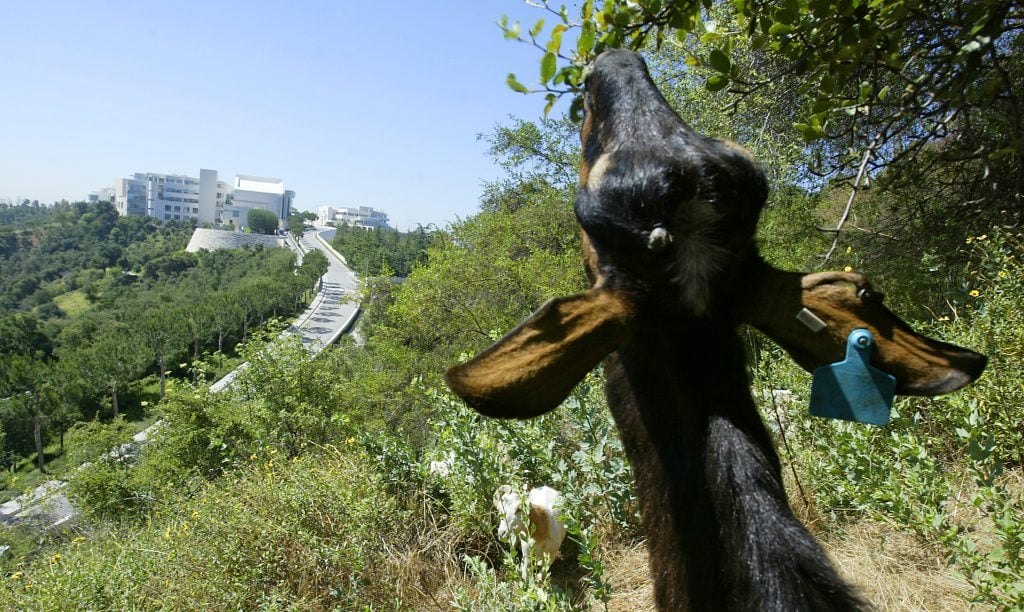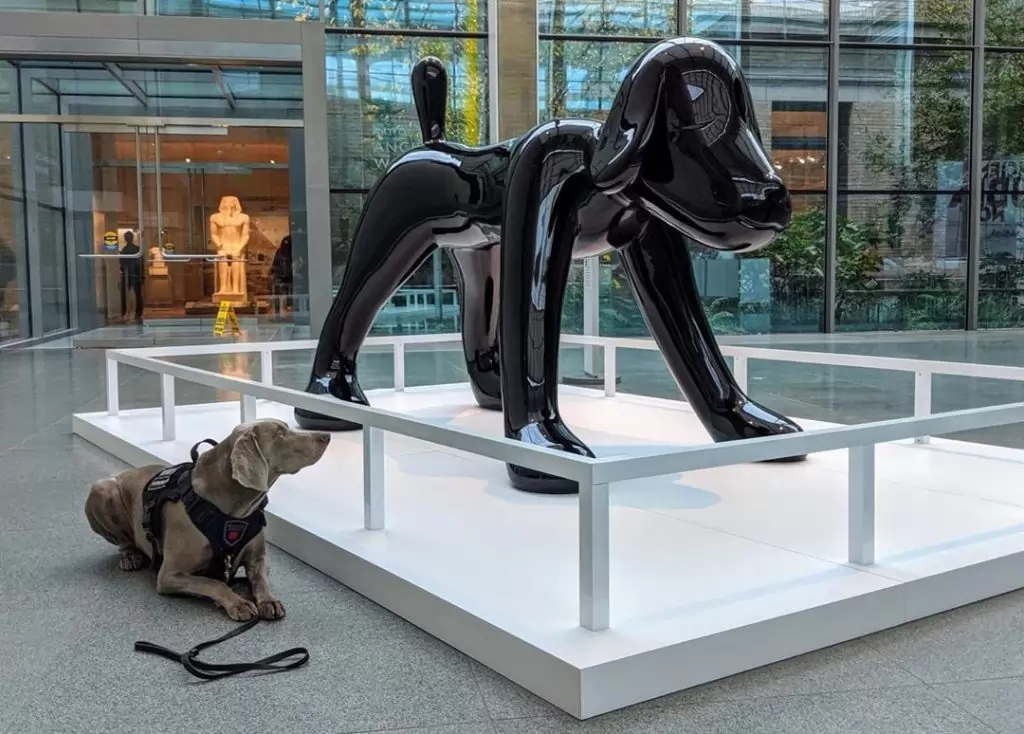Last week, New York’s Metropolitan Museum of Art revealed on Instagram that a mother duck had moved in, and was currently nesting on the Cantor Roof Garden, which is home (under normal circumstances) to a seasonal contemporary art installation and a pricey bar..
The museum quickly got in touch with the New York City Parks Department about relocating the mother and her forthcoming ducklings down to Central Park, but also invited art lovers to suggest names for the animal while she was visiting. (Candidates include “Friduck Kahlo,” “Leonora Quackington,” the gender-bending “Quackson Pollock,” and “Maduck X.”)
The duck family will likely have moved on by the time the museum reopens August 29, but as it turns out, they aren’t the only animals on the premises: several fish live in the koi pond in the museum’s Astor Court.
That makes the Met something of a rarity—lots of museums have famous masterpieces, but it is far rarer to boast animals in residence.
Here are a few of our favorite animals that can be found at institutions across the US. (Cultured animals overseas include the Tate Modern’s resident parking lot cat, Mildred, in London and Gli the cat at the Hagia Sophia, who will remain even as the museum transitions back into a mosque.)
Riley, Scent Dog
Museum of Fine Arts, Boston

Scent dog in Riley with Yoshitomo Nara’s Your Dog (2003) at the Museum of Fine Arts, Boston. Photo courtesy of the Museum of Fine Arts, Boston.
In 2018, the MFA Boston made an unusual hire: Riley, a 12-week-old Weimaraner puppy. The adorable canine actually belongs to Nicki Luongo, the museum’s head of protective services, who trained Riley to detect bug infestations that could endanger the museum’s collection.
Weimaraners have a strong sense of smell, making them well-suited to the task of identifying test—a task that has even inspired a children’s book.
Even with the museum currently closed, “Riley is still working hard,” a museum spokesperson told Artnet News in an email. “He’s mostly behind the scenes, but before closure he would occasionally interact with the public. Nicki does demonstrations with him sniffing out hidden pests and always includes tips on owning a dog safely.”
Donkeys
Magazzino Italian Art, Cold Spring

Sardinian donkeys Dina, Donna, Donatella, and Dino at Magazzino Italian Art. Photo by Marco Anelli, courtesy of Magazzino Italian Art, Cold Spring, New York.
In 2017, husband and wife collectors Nancy Olnick and Giorgio Spanu unveiled Magazzino, a new museum dedicated to their collection contemporary Italian art in Cold Spring, New York.
The couple already had a home and artist residency program with a working farm in nearby Garrison, so when the art space opened, they moved over a quartet of Sardinian donkeys—Dina, Donna, Donatella, and Dino—to go with the art.
“In Sardinia, people use donkeys widely to assist with farming–they almost function as a tractor would, but they have the added benefit of being such friendly, loving animals,” Spanu, who grew up on the Italian island, told Artnet News. “Having the donkeys around brings back memories of my childhood.”
The donkeys live an idyllic life on the property’s rolling hills, he added, running around in the mornings, greeting visitors throughout the day, and enjoying organic meals of hay and barely each night. Museum shuttle driver Jay Nicholas, who visited the animals during lockdown, playing for them on guitar, also regularly brushes the donkeys—”which they love,” said Spanu.
Perilla and Cleome, Garden Cats
Philbrook Museum of Art, Tulsa

Cleome, one of the garden cats at the Philbrook Museum of Art in Tulsa. Photo courtesy of the Philbrook Museum of Art, Tulsa
Keep your eye out for a pair of cats prowling the gardens at the Philbrook Museum. Perilla and the youngster Cleome, who was dropped off a the museum as a kitten, are always willing to pose for photos or accept a good cat scratch from visitors. And the human staff are more than happy to share their space with feline workers.
“They help with pest control and the guests love them,” boasts the museum website. “Our cats live a lavish life with heat in the winter and A/C in the summer.”
And with museums struggling financially this year thanks to months-long closures, the industrious duo “recently started dealing catnip to the neighborhood cats to help the museum’s bottom line,” wrote the Philbrook on Instagram. “We didn’t ask them to do this, but we are impressed.”
Emma, Docent Dog
University of Missouri’s Museum of Art and Archaeology, Columbia

Emma the dog docent at the University of Missouri’s Museum of Art and Archaeology. Photo by Rob Hill, courtesy of the University of Missouri.
Emma, a standard poodle, is the official canine tour guide and ambassador for the University of Missouri’s Museum of Art and Archaeology. Quite possibly the country’s first dog museum docent, 11-year-old Emma was trained for her duties from puppyhood by her owner, museum volunteer Kathryn Lucas.
A hit with museum visitors of all stripes—from university medical residents in the museum’s Art in Medicine Experience Program to school children on field trips—Emma represents a welcome exception from museum prohibitions against touching.
When stressed out med students “are greeted by a waggy-tail, grinning poodle, they visibly relax and invariably stroke her fur in response to her doggy smiles,” Lucas told Artnet News in an email. “Many continue to randomly pet her as we progress through the session, appearing to be soothed by the feel of her fur.”
Polydactyl Cats
Ernest Hemingway Home and Museum, Key West

Polydactyl cats Capt Tony, Benny Goodman, and Fats Waller at the Ernest Hemingway Home and Museum, Key West.
The Ernest Hemingway Museum pays tribute to the great American writer, but its also well known for its large population of six-toed cats, said to be descended from Hemingway’s own cat, Snowball.
The cats, typically named after celebrities, became so well known that they actually attracted the attention of the Department of Agriculture—a lawsuit at the United States Court of Appeals for the 11th Circuit found in 2012 that the agency had the power to regulate the museum’s popular polydactyl felines.
Today, the museum’s cats boast over 15,000 Instagram followers who enjoy watching their leisurely life by the pool, hanging out with visiting iguanas, and celebrating guest’s birthdays.
Various Animal Ambassadors
Randall Museum, San Francisco

The Randall Museum is home to a rescued raccoon. Photo courtesy of Randall Museum Friends.
The Randall Museum bills itself as “a natural history museum, science museum, and arts center in one,” but it’s also part zoo, thanks to some 100 resident “animal ambassadors” that help teach visitors about local wildlife and conservation.
The resident critters range from a cuddly domestic rabbit to a barn owl to a desert hairy scorpion. Much of the museum’s animal population is made up of rescued creatures.
“Different rehabilitation centers all over California (and beyond) have the Randall Museum on a list of potential places that may be able to house animals that have been injured or can not survive in the wild,” Genevieve Antaky, a representative of the museum, told Artnet News in an email.
Among visitor favorites is the raccoon that joined the crew in 2013. Some media reports have referred to him as Edward, but the museum has a strict policy against naming wild animals, to avoid anthropomorphizing them.
Instead, the museum strives to replicate the animals’ natural environment, to teach visitors about California’s different habitats, from the desert to chaparral to forests to urban areas.
Honorable Mention: Goats
Getty Center, Los Angeles

A goat dines on leaves of a scrub oak north of the Getty Museum. The museum brought in nearly 300 goats to help clear eight acres of hillside around the Getty Center as part of its fire season preparations. Photo by Ken Hively/Los Angeles Times/Getty Images.
The J. Paul Getty Museum has to pay close attention to clearing the brush on its 110-acre hillside campus ahead of California’s fire season each year. In 2007 and 2008, those efforts including bringing in a fleet of goats to graze on flammable brush—a much cuter alternative to chainsaws, not to mention more environmentally friendly.
The goats came with their own goatherd, Hugh Bunten, and his dogs Steve and Boo, who protected the flock from coyotes while living in a tent on the Getty grounds. (The Getty hired the goats through Bunten’s company, a “vegetative management company” based in Oregon.)
Unfortunately for goat lovers, the Getty has relied on more conventional means of brush-clearing in the years since. “There are companies who bring flocks of goats to different locations, they graze awhile and then move on to the next gig,” Getty press rep Julie Jaskol told Artnet News in an email. “Not like we had on-staff goats. Alas, we haven’t had them back!”
The post Here Are 7 Amazing Stories of Animals That Live in Museums, From a Dog Docent in Missouri to a Donkey Crew in New York appeared first on artnet News.


 DUCK ALERT
DUCK ALERT 
 Met staff are keeping an eye on our feathered friend and have enlisted the help of @nycparks Urban Park Rangers to assist in transporting mama and her ducklings to the Central Park pond when they’re ready to make a move. In the meantime, we’re falling in love and searching for the perfect name for our sweet little lady.
Met staff are keeping an eye on our feathered friend and have enlisted the help of @nycparks Urban Park Rangers to assist in transporting mama and her ducklings to the Central Park pond when they’re ready to make a move. In the meantime, we’re falling in love and searching for the perfect name for our sweet little lady.  Drop your most egg-cellent name suggestions in the comments below. (Extra points if they’re art-themed!) [Image descriptions: A brown duck nests comfortably in a planter on The Met’s roof. An alternate angle of the same duck nesting amidst bright green foliage.]
Drop your most egg-cellent name suggestions in the comments below. (Extra points if they’re art-themed!) [Image descriptions: A brown duck nests comfortably in a planter on The Met’s roof. An alternate angle of the same duck nesting amidst bright green foliage.]